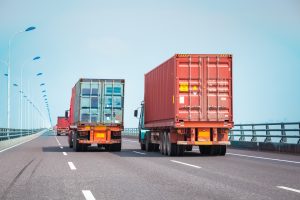#3 and Final Installment in a Series: “IoT ̶ a Supply Chain Game-Changer”
So far in this series, I have talked about a couple of primary areas in which the Internet of Things (IoT) is increasing productivity in several key components in today’s supply chain. The first post talked about its influence in manufacturing, right there on the factory floor. The second addressed warehousing and distribution, where IoT has made warehouse inventory management more efficient, and enhancing picking and sortation processes to help deliver parts and products more accurately and efficiently. Today, I’d like to close the series with a look at IoT from another standpoint.
A supply chain is a dynamic process, and you can’t asses its performance without looking at what happens while products and materials are in transit, moving from source to warehouse or factory, and then on to a manufacturer or to the business or consumer end user. That’s my subject today; and that’s where the Internet of Things offers significant improvement in not only speed of delivery, but in shipment tracking, accuracy, and the maintenance of quality standards.
Today, “Where It’s At” Isn’t Where It’s At
Old-school logistics operations had a fairly simple mission: know where your shipment is at any given time. Think “old war movie”, with generals plotting troop and artillery movements with little pieces on a table map based on days-old field reports and garbled radio messages. In similar fashion, supply chain information was normally gleaned from various reports submitted by people in the field as products and materials were sent from one place to another.
In today’s environment, efficiency requires knowing more than where something is supposed to be. And thanks to things like cloud-based GPS monitoring and RFID tags, those shipments themselves can provide real-time data on not only where they are, but how they’re doing. Think back to that war room. Instead of information based upon scribbled messages and garbled radio reports days old, what if those pieces on the map were able to report their exact location, the conditions they were facing on the ground, the weather, and any other information relevant to the proper utilization?
Thanks to the Internet of Things, that’s the kind of information available to logistics managers today. In addition to real-time in-transit visibility, a great deal more information is made available. In addition to RFID tags (which in many cases can be placed on individual products), sensors can be placed in pallets, and in the vehicles transporting them. The information reported from all those monitoring devices, combined with environmental data obtained from other sources (simple traffic sensors, etc.) can allow for much tighter control and management of the process.
IoT Provides Actionable Information
These factors include weather conditions, traffic reports, individual driver habits and patterns, and other important elements in getting from here to there. But they also can include product condition and handling reports. Are required temperatures (and as a result, product quality) being maintained? Credible sources report that about one-third of food perishes in transit every year due to “cold chain” failures.
Do pallets arrive in peak condition? Does loading and in-trailer positioning have an impact on that? Do shipments sit an excessive amount of time between reaching the destination and being unloaded? This kind of information can, at a minimum, allow for fine-tuning of the process for maximized performance. But it can also help reduce asset loss, and help save real money.
Real-time, Real-world Benefits
Since examples always help us visualize concepts, think about some of the things IoT makes possible:
- Save time and fuel costs simply by helping drivers avoid traffic jams and take the most efficient route.
- Improve fleet management, routing trucks more efficiently and reducing “deadhead” miles that are costly fuel costs, driver time, and unavailable assets.
- Identify the sources of shrinkage, shining a spotlight on where materials or merchandise is lost or damaged.
- Better understand variables like driver performance and cargo handling procedures.
- Smaller, more “agile” transportation providers can use IoT to compete effectively, driving down costs for manufacturers and keeping consumer costs lower.
It’s not a new concept, but it’s never been more accurate: information is power. And through IoT, companies have access to a great deal more information from and about their supply chain. And it seems to me, their ability to use it effectively will have a huge impact on the success of their enterprise. Has the Internet of Things had an impact on your business yet? Could it? I’d love to chat about it; give me a call. It’s no longer just a good idea to stay current on things like this. It’s mandatory, if you want to stay in business.




